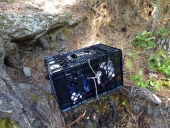***** - Water Usage
*** - Speediness
**** - Cleanliness
* - That 'Ahhhh' feeling of standing in a warm shower
I've done camping trips out in the desert where my stay is entirely limited by how long a 6gal jug of water will last. This is strongly at odds with my dislike of being stinky. I have heard and seen many tricks for low water showers, but haven't come across any that get as clean with as little water as this technique. If you do have suggestions though, please post them.
Boundary Layers - as a liquid or gas flows over a surface, it's velocity drops rapidly right near that surface. This is relevant here because when we shower normally, the vast majority of the water skirts across above the boundary layer, doesn't mix much with the dirt and soap, and goes down the drain more or less as it started; pretty clean. The biggest trick for saving water while showering, or washing any surface I suppose, is getting as much of that water to slow down and interact close to the surface as possible.
Enter the cheap little hand pump sprayer from the hardware store! If I were allowed only five items to take on a camping trip, this thing would easily make the list. It is amazing for washing dishes, brushing teeth, washing your face, extinguishing small fires, and it works really well as a wilderness bidet. I'm not going to go into all that right now though, because I primarily use it for showering.
The steps are the same as a normal shower:
1. Wet everything down
2. Soap everywhere
3. Rinse soapy water off
But there are some slight tweaks along the way. In step 1, use the pump sprayer on the fine mist setting so that almost no water runs off, simple enough. In step 2, don't over-apply soap. It really doesn't take much at all to saturate this small amount of water you just sprayed on. Sure, use more in the business areas, but just don't overdo it. Now in step 3, don't do that random rubbing your hands in all directions stuff from step 2, we're past that now. Imagine that your hand is a squeegee like you would use to clean a windshield, and that every pass has the intent of wiping off soapy water in a downward direction. The intentionality here is a big water saver, and you'll find that all the soap is gone really quickly.
Some other notes:
- Heating the water up in a pot on the stove or in a solar oven makes this more enjoyable and even a bit more water-efficient as the warm water cleans better.
- Soap is integral to this technique. There are probably a lot of good poo-less shower ideas on these forums, but I feel you need soap if you are using this little water. Liquid soaps are better for a couple reasons in my opinion. Liquid soaps generally use potassium hydroxide for saponification while bar soaps generally use sodium hydroxide. This concentration of sodium in the soil is not usually appreciated by growies, as I found out while doing a lot of shower greywater reuse last year. I have also found, and I don't know the chemical explanation for this, that liquid soap washes off a lot more easily in soft water, helping even more with conservation. None of these companies pay me, but I have found that Oasis, Dr. Bronners, and
this soap all work well and don't seem to bother most plants.
- You can make the pump sprayer operate hands-free by wrapping some string or a rubber band around the handle by the trigger, then putting in a small stick or something to activate it. I just usually swap it back and forth between hands instead though.
- Long haired people are probably screaming at the screen by this point in the post. It might take double the amount of water or more if you have a lot of hair and are washing it too. I welcome any tips to save water for this step since none of my tricks from above really apply.
- Using a dry washcloth or hand towel between steps 2 and 3 to wipe off most of the dirty, soapy water saves even more water when rinsing. I got out of the habit of doing this though, because you can only get a couple uses before the cloth needs to be laundered. If you have an extreme lack of water and an excess of towels though it might be worth considering.
This is part of the
MoPID series of permaculture innovations that I am working on during my time at Wheaton Labs. Check out the thread if you'd like to follow along.









